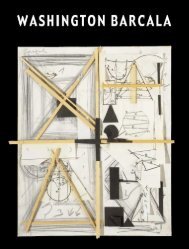Lanzarote: el papel de la crisis - Fundación César Manrique
Lanzarote: el papel de la crisis - Fundación César Manrique
Lanzarote: el papel de la crisis - Fundación César Manrique
You also want an ePaper? Increase the reach of your titles
YUMPU automatically turns print PDFs into web optimized ePapers that Google loves.
disfigured? Who sacrifices them? Whither do the extinct is<strong>la</strong>nds go? Do the is<strong>la</strong>nds alone<br />
know or do men also know something about how they go adrift?<br />
As the Is<strong>la</strong>nd is reached, a vague sound can be heard or, to be more precise, if the keen<br />
observer uses his eyes as w<strong>el</strong>l as his ears, then, whoever he may be, he will soon realise that<br />
the sound is loud and clear. It is not the sound of light, <strong>de</strong>spite our b<strong>el</strong>ief that we have<br />
arrived at the <strong>de</strong>stiny of light, for it is a known fact that the sound of light is a very quiet,<br />
intravenous sound which creeps into the rest of our senses before making its<strong>el</strong>f heard.<br />
In<strong>de</strong>ed, we have the impression that we are standing before the sound of a beautiful body<br />
which is yi<strong>el</strong>ding to the pressure of the cracks. A kind of living canvas cracking un<strong>de</strong>r a<br />
sud<strong>de</strong>n change in the climate, of a force which sw<strong>el</strong>ls the cloth that is imprisoned between<br />
the edges of the frame. The sound of cracking. A body which, before its limbs fall away, starts<br />
to fe<strong>el</strong> the effects of the erosion caused by the cracks. The sound of an is<strong>la</strong>nd as it breaks<br />
up. And the muttering of men and women who breathe in the air coming through the cracks,<br />
who cause the cracks, who consent to the cracks from amid shadows of indolence, or who<br />
<strong>de</strong>nounce them and suggest that new windows be opened onto the horizon so that the<br />
<strong>de</strong>stiny of light will never fa<strong>de</strong> away. <strong>Lanzarote</strong>.<br />
II. That story, this story: the same old story<br />
There is nothing new. If the second half of the eighties brought an expansive cycle in the<br />
tourism and real estate sector, affecting all walks of life on the is<strong>la</strong>nd until it produced a<br />
scenario of risk which became a source of concern for society in general, in the early<br />
nineties, <strong>Lanzarote</strong> un<strong>de</strong>rwent a major recession. Of this process, fu<strong>el</strong>led by powerful<br />
centrifugal forces which challenged the strategies uph<strong>el</strong>d by <strong>César</strong> <strong>Manrique</strong> and, more<br />
generally, compromised the is<strong>la</strong>nd’s territorial and social integrity, was born the need to<br />
or<strong>de</strong>r and regu<strong>la</strong>te both touristic activity and the occupation of the territory. In 1991, the<br />
go-ahead was given to the P<strong>la</strong>n Insu<strong>la</strong>r <strong>de</strong> Or<strong>de</strong>nación d<strong>el</strong> Territorio or PIOT (is<strong>la</strong>nd p<strong>la</strong>n for<br />
the organisation of the territory), whereby, amongst other <strong>de</strong>cisive regu<strong>la</strong>tions, the 250,000<br />
tourist and resi<strong>de</strong>ntial accommodation p<strong>la</strong>ces envisaged un<strong>de</strong>r various partial municipal<br />
p<strong>la</strong>ns were reduced to a total of 112,336 beds up to the year 2000. Today, however, the<br />
170
















![Becas y premios de la Fundación César Manrique [1997-2006]](https://img.yumpu.com/20766851/1/184x260/becas-y-premios-de-la-fundacion-cesar-manrique-1997-2006.jpg?quality=85)
